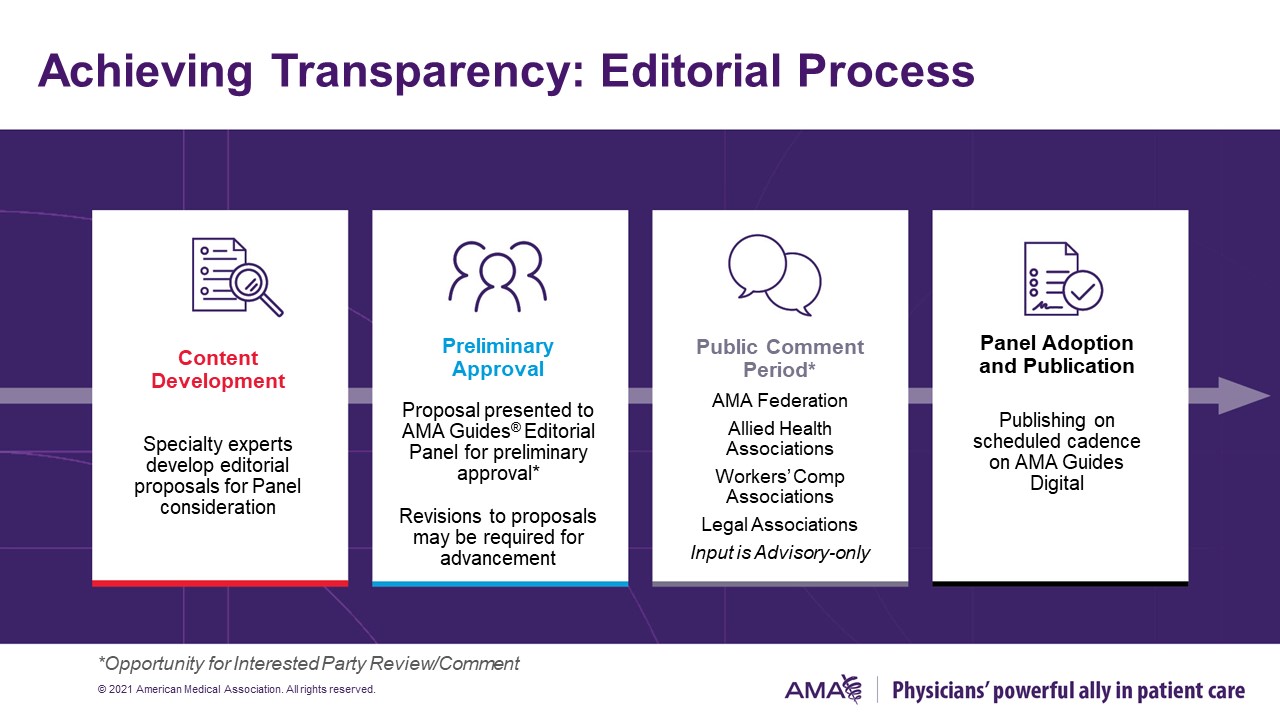
J. Mark Melhorn, MD and Douglas W. Martin, MD
The AMA Guides Editorial Panel is enabling fair and equitable permanent impairment ratings by delivering the most current medical advancements through annual updates to the AMA Guides® to the Evaluation of Permanent Impairment.
Read about the importance of using the most current medicine to evaluate patients from the AMA Guides Editorial Panel Co-Chairs — Doug Martin, MD, an occupational medicine physician from Iowa, and Mark Melhorn, MD, a hand specialist orthopaedic surgeon from Kansas — in the Q&A below.
Why is using the most current medicine in the AMA Guides important?
Dr. Melhorn: New medical advances improve outcomes beyond what is anticipated or commonly experienced in the past, or conversely, new research can identify that impairment may be more substantial than previously believed. If the AMA Guides remain static without updates that consider the latest medicine and patient outcomes, impairment will be systemically overrated or underrated.
Can you provide examples of new medical advances that are incorporated within the AMA Guides and how permanent impairment ratings are impacted?
Dr. Martin: When I started practice in the early 1990s, cardiac arrythmias put a lot of people out of work. We had medications that treated these conditions, but the side effects led to other limitations on activities of daily living. Now we have electrophysiological ablation — no medications, just a “one and done” procedure with limited adverse effects on daily living and patient function. However, older editions of the AMA Guides rate arrythmias with consideration of outcomes associated with the outdated treatment protocol, often leaving patients with higher ratings that are not reflective of their true condition.
Dr. Melhorn: This is also true for innovation in arthroscopic surgery for rotator cuff repairs for shoulders and femoroacetabular impingement for hips, for example. Arthroscopy may provide less invasive treatments. With newer procedures, we see patients returning to work or sports sooner. These advancements in healthcare require new approaches to rating impairment that are not addressed in editions of the AMA Guides that were published over 20 years ago. New procedures require updated methods for providing fair and equitable impairment ratings for functional loss.
Dr. Martin: That’s right. And sometimes, the medicine is missing altogether. The sixth edition is the only edition of the AMA Guides to address ankle replacement surgery impairment, so in older editions of the AMA Guides, such as the fifth edition, there is no guidance on how to rate this, and physicians just have to do their best with the methods provided in that particular edition, which may lead to inconsistencies in practice. Medical science does not evolve uniformly across body systems, so the use of current science is critical to achieving consistent and fair impairment ratings.
What is the impact on patients?
Dr. Melhorn: Providing timely, accurate and equitable impairment ratings allows patients to focus on recovery and return to work with a reduction in distractions that result in additional functional loss. Treatment goals include better outcomes, which are impacted by appropriate evidence-based impairment ratings.
How are the AMA Guides being updated?
Dr. Melhorn: The new AMA Guides Editorial Panel has a transparent update process, which creates a pathway to continuously update the AMA Guides with the current best evidence-based medicine. This approach will help ensure that future impairment ratings are fair and equitable. The AMA Guides Editorial Panel uses a transparent, multi-stakeholder public process and encourages input from the community at large.
Dr. Martin: All stakeholders are invited to develop and submit change proposals to update the AMA Guides in their areas of expertise for the Editorial Panel to consider. The goal of providing physicians and other qualified health care professionals with authoritative guidance based on the best available evidence and expert consensus remains unchanged.

Effective July 1, 2021, the AMA considers the AMA Guides Sixth 2021 to be the most current version of the AMA Guides. The updated version is currently available on AMA Guides Digital for review, with educational support available through AMA EdHub™.
Going forward, the AMA Guides will be maintained exclusively online.

This article was provided to The Arizona Pulse by the American Medical Association (AMA). Founded in 1847, the AMA is the largest and only national association that convenes 190+ state and specialty medical societies and other critical stakeholders. Throughout history, the AMA has always followed its mission: to promote the art and science of medicine and the betterment of public health. Click here to visit the AMA’s website or here to view the AMA Guides website.
The provider of The Arizona Pulse, the Arizona Medical Association (ArMA), works closely with the AMA. Click here to visit ArMA’s website.
Check out our other recent articles!
Medical Students Lead Initiative to Engage Patients in Civic Health
Written by: Pareena Kaur, Briana Corkill, Rebia Khan, Abigail Solorio, [...]
Elderly Falls… A Hidden Crisis
Written by: Babak M. Nayeri, NMD, MS, FABMP, FABFM, and [...]
Letter from the Editor – Winter 2019
Colleagues, The staff at the Arizona Medical Association (ArMA) and [...]








